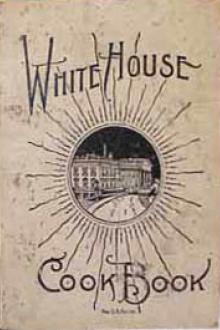The Whitehouse Cookbook (1887), Hugo Ziemann [world of reading .TXT] 📗

- Author: Hugo Ziemann
- Performer: -
Book online «The Whitehouse Cookbook (1887), Hugo Ziemann [world of reading .TXT] 📗». Author Hugo Ziemann
STEAMED CABBAGE.
Take a sound, solid cabbage, and with a large sharp knife shave it very fine. Put it in a saucepan, pour in half a teacupful of water, or just enough to keep it from burning; cover it very tightly, so as to confine the steam; watch it closely, add a little water now and then, until it begins to be tender; then put into it a large tablespoonful of butter; salt and pepper to taste, dish it hot. If you prefer to give it a tart taste, just before taking from the fire add a third of a cup of good vinegar.
LADIES' CABBAGE.
Boil a firm white cabbage fifteen minutes, changing the water then for more from the boiling tea-kettle. When tender, drain and set aside until perfectly cold. Chop fine and add two beaten eggs, a tablespoonful of butter, pepper, salt, three tablespoonfuls of rich milk or cream. Stir all well together, and bake in a buttered pudding-dish until brown. Serve very hot. This dish resembles cauliflower and is very digestible and palatable.
FRIED CABBAGE.
Place in a frying pan an ounce of butter and heat it boiling hot. Then take cold boiled cabbage chopped fine, or cabbage hot, cooked the same as steamed cabbage, put it into the hot butter and fry a light brown, adding two tablespoonfuls of vinegar. Very good.
FRENCH WAY OF COOKING CABBAGE.
Chop cold boiled white cabbage and let it drain till perfectly dry: stir in some melted butter to taste; pepper, salt and four tablespoonfuls of cream; after it is heated through add two well-beaten eggs; then turn the mixture into a buttered frying pan, stirring until it is very hot and becomes a delicate brown on the under side. Place a hot dish over the pan, which must be reversed when turned out to be served.
SOURCROUT.
Barrels having held wine or vinegar are used to prepare sourcrout in. It is better, however, to have a special barrel for the purpose. Strasburg, as well as all Alsace, has a well-acquired fame for preparing the cabbages. They slice very white and firm cabbages in fine shreds with a machine made for the purpose. At the bottom of a small barrel they place a layer of coarse salt and alternately layers of cabbage and salt, being careful to have one of salt on the top. As each layer of cabbage is added, it must be pressed down by a large and heavy pestle and fresh layers are added as soon as the juice floats on the surface. The cabbage must be seasoned with a few grains of coriander, juniper berries, etc. When the barrel is full it must be put in a dry cellar, covered with a cloth, under a plank, and on this heavy weights are placed. At the end of a few days it will begin to ferment, during which time the pickle must be drawn off and replaced by fresh, until the liquor becomes clear. This should be done every day. Renew the cloth and wash the cover, put the weights back and let stand for a month. By that time the sourcrout will be ready for use. Care must be taken to let the least possible air enter the sourcrout and to have the cover perfectly clean. Each time the barrel has to be opened it must be properly closed again. These precautions must not be neglected.
This is often fried in the same manner as fried cabbage, excepting it is first boiled until soft in just water enough to cook it, then fry and add vinegar.
TO BOIL RICE.
Pick over the rice carefully, wash it in warm water, rubbing it between the hands, rinsing it in several waters, then let it remain in cold water until ready to be cooked. Have a saucepan of water slightly salted; when it is boiling hard, pour off the cold water from the rice, and sprinkle it in the boiling water by degrees, so as to keep the particles separated. Boil it steadily for twenty minutes, then take it off from the fire and drain off all the water. Place the saucepan with the lid partly off, on the back part of the stove, where it is only moderately warm, to allow the rice to dry. The moisture will pass off and each grain of rice will be separated, so that if shaken the grains will fall apart. This is the true way of serving rice as a vegetable and is the mode of cooking it in the Southern States where it is raised.
PARSNIPS, BOILED.
Wash, scrape and split them. Put them into a pot of boiling water; add a little salt, and boil them till quite tender, which will be in from two to three hours, according to their size. Dry them in a cloth when done and pour melted butter or white sauce (see SAUCES) over them in the dish. Serve them up with any sort of boiled meat or with salt cod.
Parsnips are very good baked or stewed with meat.
FRIED PARSNIPS.
Boil tender in a little hot water salted; scrape, cut into long slices, dredge with flour; fry in hot lard or dripping, or in butter and lard mixed; fry quite brown. Drain off fat and serve.
Parsnips may be boiled and mashed the same as potatoes.
STEWED PARSNIPS.
After washing and scraping the parsnips slice them about half of an inch thick. Put them in a saucepan of boiling water containing just enough to barely cook them; add a tablespoonful of butter, season with salt and pepper, then cover closely. Stew them until the water has cooked away, watching carefully and stirring often to prevent burning, until they are soft. When they are done they will be of a creamy light straw color and deliciously sweet, retaining all the goodness of the vegetable.
PARSNIP FRITTERS.
Boil four or five parsnips; when tender take off the skin and mash them fine; add to them a teaspoonful of wheat flour and a beaten egg; put a tablespoonful of lard or beef drippings in a frying pan over the fire, add to it a saltspoonful of salt; when boiling hot put in the parsnips; make it in small cakes with a spoon; when one side is a delicate brown turn the other; when both are done take them on a dish, put a very little of the fat in which they were fried over and serve hot. These resemble very nearly the taste of the salsify or oyster plant, and will generally be preferred.
CREAMED PARSNIPS.
Boil tender, scrape and slice lengthwise. Put over the fire with two tablespoonfuls of butter, pepper and salt and a little minced parsley. Shake until the mixture boils. Dish the parsnips, add to the sauce three tablespoonfuls of cream or milk in which has been stirred a quarter of a spoonful of flour. Boil once and pour over the parsnips.
STEWED TOMATOES.
Pour boiling water over a dozen sound ripe tomatoes; let them remain for a few moments; then peel off the skins, slice them and put them over the fire in a well-lined tin or granite-ware saucepan. Stew them about twenty minutes, then add a tablespoonful of butter, salt and pepper to taste; let them stew fifteen minutes longer and serve hot. Some prefer to thicken tomatoes with a little grated bread, adding a teaspoonful of sugar; and others who like the flavor of onion chop up one and add while stewing; then again, some add as much green corn as there are tomatoes.
TO PEEL TOMATOES.
Put the tomatoes into a frying basket and plunge them into hot water for three or four minutes. Drain and peel. Another way is to place them in a flat baking-tin and set them in a hot oven about five minutes; this loosens the skins so that they readily slip off.
SCALLOPED TOMATOES.
Butter the sides and bottom of a pudding-dish. Put a layer of bread crumbs in the bottom; on them put a layer of sliced tomatoes; sprinkle with salt, pepper and some bits of butter, and a very little white sugar. Then repeat with another layer of crumbs, another of tomato and seasoning until full, having the top layer of slices of tomato, with bits of butter on each. Bake covered until well cooked through; remove the cover and brown quickly.
STUFFED BAKED TOMATOES.
From the blossom end of a dozen tomatoes—smooth, ripe and solid—cut a thin slice and with a small spoon scoop out the pulp without breaking the rind surrounding it; chop a small head of cabbage and a good-sized onion fine and mix with them fine bread crumbs and the pulp; season with pepper, salt and sugar and add a cup of sweet cream; when all is well mixed, fill the tomato shells, replace the slices and place the tomatoes in a buttered baking-dish, cut ends up and put in the pan just enough water to keep from burning; drop a small lump of butter on each tomato and bake half an hour or so, till well done; place another bit of butter on each and serve in same dish. Very fine.
Another stuffing which is considered quite fine. Cut a slice from the stem of each and scoop out the soft pulp. Mince one small onion and fry it slightly; add a gill of hot water, the tomato pulp and two ounces of cold veal or chicken chopped fine, simmer slowly and season with salt and pepper. Stir into the pan cracker dust or bread crumbs enough to absorb the moisture; take off from the fire and let it cool; stuff the tomatoes with this mass, sprinkle dry crumbs over the top; add a small piece of butter to the top of each and bake until slightly browned on top.
BAKED TOMATOES. (Plain.)
Peel and slice quarter of an inch thick; place in layers in a pudding-dish, seasoning each layer with salt, pepper, butter and a very little white sugar. Cover with a lid or large plate and bake half an hour. Remove the lid and brown for fifteen minutes. Just before taking from the oven pour over the top three or four tablespoonfuls of whipped cream with melted butter.
TO PREPARE TOMATOES. (Raw.)
Carefully remove the peelings. Only perfectly ripe tomatoes should ever be eaten raw and if ripe the skins easily peel off. Scalding injures the flavor. Slice them and sprinkle generously with salt, more sparingly with black pepper, and to a dish holding one quart, add a light tablespoonful of sugar to give a piquant zest to the whole. Lastly, add a gill of best cider vinegar; although, if you would have a dish yet better suited to please an epicurean palate, you may add a teaspoonful of made mustard and two tablespoonfuls of rich sweet cream.
FRIED AND BROILED TOMATOES.
Cut firm, large, ripe tomatoes into thick slices, rather more than a quarter of an inch thick. Season with salt and pepper, dredge well with flour, or roll in egg and crumbs, and fry them brown on both sides evenly, in hot butter and lard mixed. Or, prepare them the same as for frying, broiling on a well-greased gridiron, seasoning afterward the same as beefsteak. A good accompaniment to steak. Or, having prepared the following sauce, a pint of milk, a tablespoonful of flour and one beaten egg, salt, pepper and a very little mace; cream an ounce of butter,





Comments (0)